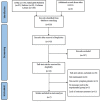Effectiveness of therapeutic massage for improving motor symptoms in Parkinson's disease: A systematic review and meta-analysis
- PMID: 36133798
- PMCID: PMC9483027
- DOI: 10.3389/fneur.2022.915232
Effectiveness of therapeutic massage for improving motor symptoms in Parkinson's disease: A systematic review and meta-analysis
Abstract
Background: Parkinson's disease (PD) causes movement disorders [called motor symptoms (MS)], and motor dysfunction poses a great barrier to the quality of life. Although pharmacological therapy like levodopa can relieve the symptoms, it can also cause complications, such as psychosis, nausea, and dyskinesia. A therapy with more minor side effects is needed for PD. Therapeutic massages are the most commonly used forms of complementary and alternative medicine (CAM), but no systematic review and meta-analysis have focused on the efficacy of massage on PD.
Objective: To evaluate the quality of evidence and efficacy of therapeutic massage for improving MS in PD.
Methods: We independently searched four electronic databases, including Chinese National Knowledge Infrastructure (CNKI), MEDLINE/PubMed, Embase, and Cochrane Library, for randomized controlled trials (RCTs) about therapeutic massage and other available manual therapies improving MS in PD from January 1, 2012, to December 31, 2021 (recent 10 years). The main outcome measures were total effectiveness and the Unified Parkinson's Disease Rating Scale (UPDRS), including UPDRS total, II, and III. For the statistical analysis, the risk ratio, standard mean difference, and 95% confidence interval (CI) were used to calculate effect sizes between groups. To determine heterogeneity, statistical index I 2 was used.
Results: A total of 363 PD participants in seven RCTs and one randomized pilot-control study were included in this meta-analysis. The total effectiveness showed that therapeutic massage was more effective than the intervention of the control group for improving MS [ratio risk (RR): 1.33, 95% CI (1.14-1.55), p = 0.0002]. The UPDRS-III scores showed that massage improves motor function more than the control group [SMD = -0.46, 95% CI (-0.67, -0.24), p < 0.00001]. But we found that massage performed no better than the control group in improving daily life activities [SMD = -0.15, 95% CI (-0.40, 0.10), p = 0.23].
Conclusion: Therapeutic massage was effective in improving MS in PD. It is suggested to be an appropriate form of CAM in treating PD.
Systematic review registration: https://www.crd.york.ac.uk/PROSPERO/display_record.php?RecordID=323182, identifier: CRD42022323182.
Keywords: Parkinson's disease; Traditional Chinese Medicine; manual therapy (MT); meta-analyse; therapeutic massage.
Copyright © 2022 Kang, Xing, Lin, Meng and Gong.
Conflict of interest statement
The authors declare that the research was conducted in the absence of any commercial or financial relationships that could be construed as a potential conflict of interest.
Figures







Similar articles
-
Effectiveness of aerobic and resistance training on the motor symptoms in Parkinson's disease: Systematic review and network meta-analysis.Front Aging Neurosci. 2022 Aug 1;14:935176. doi: 10.3389/fnagi.2022.935176. eCollection 2022. Front Aging Neurosci. 2022. PMID: 35978948 Free PMC article.
-
Non-pharmacological therapies for treating non-motor symptoms in patients with Parkinson's disease: a systematic review and meta-analysis.Front Aging Neurosci. 2024 Apr 26;16:1363115. doi: 10.3389/fnagi.2024.1363115. eCollection 2024. Front Aging Neurosci. 2024. PMID: 38737585 Free PMC article.
-
Effect of acupuncture for non-motor symptoms in patients with Parkinson's disease: A systematic review and meta-analysis.Front Aging Neurosci. 2022 Oct 6;14:995850. doi: 10.3389/fnagi.2022.995850. eCollection 2022. Front Aging Neurosci. 2022. PMID: 36275001 Free PMC article.
-
Efficacy and safety of selegiline for the treatment of Parkinson's disease: A systematic review and meta-analysis.Front Aging Neurosci. 2023 Apr 11;15:1134472. doi: 10.3389/fnagi.2023.1134472. eCollection 2023. Front Aging Neurosci. 2023. PMID: 37113570 Free PMC article.
-
Acupuncture-Related Therapies for Parkinson's Disease: A Meta-Analysis and Qualitative Review.Front Aging Neurosci. 2021 Jul 1;13:676827. doi: 10.3389/fnagi.2021.676827. eCollection 2021. Front Aging Neurosci. 2021. PMID: 34276340 Free PMC article.
Cited by
-
Perceptions and attitudes regarding complementary, alternative, and integrative medicine among published neurology authors: a large-scale, international cross-sectional survey.BMC Neurol. 2024 Jun 24;24(1):215. doi: 10.1186/s12883-024-03661-9. BMC Neurol. 2024. PMID: 38914963 Free PMC article.
-
Will the Artificial Intelligence Touch Substitute for the Human Touch?NeuroSci. 2024 Jul 24;5(3):254-264. doi: 10.3390/neurosci5030020. eCollection 2024 Sep. NeuroSci. 2024. PMID: 39483277 Free PMC article. Review.
-
Social Touch: Its Mirror-like Responses and Implications in Neurological and Psychiatric Diseases.NeuroSci. 2023 May 26;4(2):118-133. doi: 10.3390/neurosci4020012. eCollection 2023 Jun. NeuroSci. 2023. PMID: 39483320 Free PMC article. Review.
-
Current Treatments and New, Tentative Therapies for Parkinson's Disease.Pharmaceutics. 2023 Feb 25;15(3):770. doi: 10.3390/pharmaceutics15030770. Pharmaceutics. 2023. PMID: 36986631 Free PMC article. Review.
-
Quantification of rehabilitation for patients with Parkinson's disease and related disorders using wearable devices; a proof of concept.Front Neurol. 2025 Jul 23;16:1609823. doi: 10.3389/fneur.2025.1609823. eCollection 2025. Front Neurol. 2025. PMID: 40771968 Free PMC article.
References
Publication types
LinkOut - more resources
Full Text Sources

